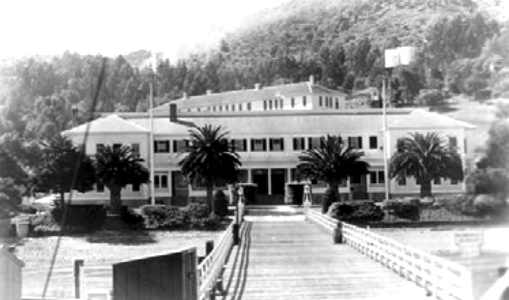The restoration of the Immigration Station on Angel Island has reached a major milestone. For the first time ever, all areas within the historically significant barracks—where priceless poems of detained Chinese immigrants are etched into the walls—will be open to the public on February 15th.

View of the Immigration Station Administration Building from the dock, probably in the 1920s (based on size of palm trees).
Published: February, 2009
The restoration of the Immigration Station on Angel Island has reached a major milestone. For the first time ever, all areas within the historically significant barracks—where priceless poems of detained Chinese immigrants are etched into the walls—will be open to the public on February 15th.
Previously, the 200,000 annual visitors to Angel Island had access only to a small portion of the barracks. The completion of the first phase has made both floors of the barracks accessible. In addition, it has created a terraced interpretive footprint of the massive administrative building, which was destroyed by fire in 1940. This work also created the infrastructure needed to complete future phases, which call for restoration of many of the additional buildings that still exist on the site.
Work began in 2005 on the $65 million, five-phase restoration project to preserve and rehabilitate Angel Island’s historic U.S. Immigration Station, the Ellis Island of the West. Some of the work focused on protecting and presenting the famous poems that were etched into the barrack walls nearly 100 years ago by Chinese immigrants seeking a new life in America.
Lured by the promise of gold and a better life, Chinese began immigrating to the United States in 1848. Legislation designed to keep them from gold mining began almost immediately and when the economy took a downturn, further legislation was passed to keep any more Chinese from entering the country. The Chinese Exclusion Act was not able, however, to keep the sons or daughters of U.S. citizens out of the country.
People attempting to emigrate from China often bought documentation that proved they were the child of someone who had been born in the United States. Proving the validity of these claims required an interrogation process; the Department of Immigration needed a place to detain these people until the interrogation could be complete. To that end, construction on the Immigration Station began in 1905 but was not completed until 1910. The facility consisted of a boat dock, barracks, a dining hall, a hospital, and rooms to conduct the interrogations.
The Immigration Station is a significant national historic treasure, said State Parks Director Ruth Coleman. The messages found in the poems provide us with a valuable history lesson about a people who were desperate to enter a new land and begin a new life, but instead, became the first nationality to be denied entrance. We are pleased that with the completion of Phase One, we will dramatically improve our ability to tell this story.
That the walls and their poems still exist today is fairly miraculous in and of itself. The Immigration Station could have been lost forever in the1970s when, along with many of the unused structures on the Island, it was scheduled for destruction. When Park Ranger Alexander Weiss toured the barracks that year, flashlight in hand, he discovered the poems carved into the walls, long since painted over. Beneath those were even more poems written in pencil and ink, and carvings covered by paint. The true number of poems has been estimated in the hundreds.
The restoration plan is broken into five phases. The main goal of this first phase has been to restore the detention barracks. The largest section of the barracks, and the largest collection of poetry, had been restricted from public access, but with the completion of Phase One, this will now be open.
Other first phase work included adding an Administrative Building footprint to better convey the size, function, and importance of this building, as well as rebuilding the covered stairway connecting the Administrative Building and barracks. Future phases will stabilize and rehabilitate the hospital, the mule barn, the POW Mess Hall and the WWII barracks, as well as convert the central heating plant into the Immigration Station Visitor Center.
Angel Island has been called many things throughout its history: Guardian of the Western Gate, Ellis Island of the West, and even the Bay Area’s Best Kept Secret. While it has transformed from a home for Native Americans to a military installation to a detention center, and finally to the bustling hub for recreation that it is now, Angel Island remains an important part of U.S. history. Once the restoration is complete, the Immigration Station—only one small part of everything the Island has to offer—will finally be preserved for future generations.
A Grand Reopening event is scheduled for Sunday, February 15th on Angel Island. The dedication ceremony will begin at 10:30 a.m. with a blessing by the Federated Indians of the Graton Rancheria, the original inhabitants of the site, and short speeches by elected officials, state parks leaders, and AIISF and community leaders. The Marin Chinese Cultural Association Lion Dance Troupe will perform at 11:35 a.m. as officials cut the ribbon to re-open the Detention Barracks. Visit www.aiisf.org for more details.

